FROM the pages of the April 1934 number of Sky Fighters:
Editor’s Note: We feel that this 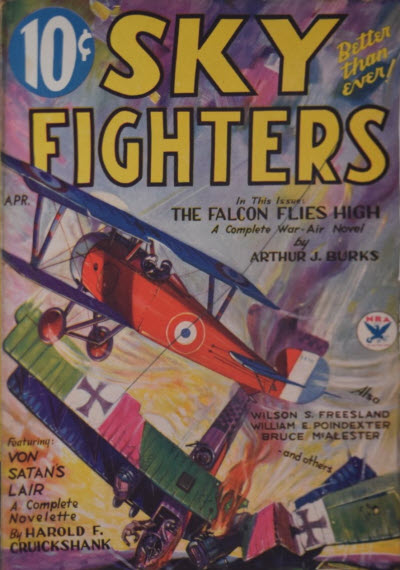 magazine has been exceedingly fortunate in securing Lt. Edward McCrae to conduct a technical department each month. It is Lt. Mcrae’s idea to tell us the underlying principles and facts concerning expressions and ideas of air-war terminology. Each month he will enlarge upon some particular statement in the stories of this magazine. Lt. MaCrae is qualified for this work, not only because he was a war pilot, but also because he is the editor of this fine magazine.
magazine has been exceedingly fortunate in securing Lt. Edward McCrae to conduct a technical department each month. It is Lt. Mcrae’s idea to tell us the underlying principles and facts concerning expressions and ideas of air-war terminology. Each month he will enlarge upon some particular statement in the stories of this magazine. Lt. MaCrae is qualified for this work, not only because he was a war pilot, but also because he is the editor of this fine magazine.
Gas Bags
by Lt. Edward McCrae (Sky Fighters, April 1934)
PRACTICALLY everyone of you young whipper-snappers that I have run across has the idea that you are living in the golden age which saw man first conquer the air. And for that reason you’re a big-headed and puffed-up lot of gas bags.
We’ll I’m sorry to have to knock the undercarriage out from under you and let a little hellium out of your inflated hides, so to speak.
The truth of the matter is that Napoleon used an aviation unit in his army. In the year 1794 a Captain J.M.J. Coutelle made the first military balloon ascent in the history of warfare. He was the world’s first military balloon observer.
At the Battle of Fleurus in Belgium during that year it was through his work as a spotter for the French artillery that the French won a victory. His observation balloon was in the air for several hours, always out over No-Man’s-Land. Much of the time he flew over the enemy’s army. He used the first hydrogen-inflated balloon, the result of his own experiments.
He later organized the world’s first balloon corps, which Napoleon used in his wars until it was destroyed during his campaign in Egypt. In the seventeen-hundreds, my children!
The First Dirigible
The first dirigible airship, the grandfather of the present Zeppelins and our own great Akron, was designed even before this date. It was the invention of a French army officer and it made use of the small ballonets which are found in the airships of today. This was shortly after the first man ever soared into the air, which happened in 1783. You ground-looping, high-chair aviators probably don’t know it, but this was going on at about the time that America was just drawing its breath after the American Revolution.
Lincoln Used ’Em
I know there’s no use in trying to cram your thick heads full of history because it would go in one ear and out the other, since there is nothing in there to stop it. So, I’ll just mention in passing that during the American Civil War old Abe Lincoln used observation balloons. And here’s something that maybe you know-it-alls didn’t know. Graf Zeppelin was an official observer attached to General Grant’s army! It was here that he made his first ascent, which resulted in his devoting the rest of his life to the dirigible, the first of which he built in 1900.
The skipper says that my job is to tell you ballonets how the war crates flew. (You remember I told you that a ballonet is a gas bag.) So, to tell you how things flew I suppose I’ll have to remind you from time to time why people wanted them to fly. Which brings us down to 1908.
The American government offered $10,000 for a “practicable military means of dirigible aerial navigation.†Such a ship was built and the Army bought it after it was test-flown at thirty miles an hour. It was ninety-six feet long and powered with a twenty-horse-power engine. Instead of having a gondola suspended under the cigar-shaped gas bag, it had an open bridgework, like the skeleton of an uncovered fuselage, upon which the aeronauts ran back and forth like a couple of monkeys in a high cage. The ship was attached to the Signal Corps. See Fig. I.

Now if you are properly humbled, and want to admit that you didn’t know there was such a thing as a flying machine before the World War, I’ll start the lesson proper. And cut out that snoring before I wrap a propeller blade around your neck.
German Dirigibles
The Germans went in for dirigibles in a big way. The whole layout or scheme of the fracas made it possible for them to use lighter-than-air craft to much better advantage than to the Allies. Just in case you don’t happen to have a war map in your pocket, I’ll try to explain the situation so that even you can get a picture of it.
The war was fought in Allied territory. The German armies were away from their home grounds. Therefore all the destruction of cities and towns was felt by Allied countries. The Germans were out to capture their enemy. The Allies’ task was to defend themselves.
Now it was a long way from the heart of Germany to Paris and to London and to the Allied centers which made up the heart of their activity, such as munition works, supply and shipping bases, and centers of population. These things the Germans wanted to destroy, while at the same time they wanted to break the morale of the non-combatant population.
Lighter Than Air
Dirigible balloons were strongly in favor for these purposes. They were self-lifting, or lighter than air, and therefore could stay aloft a great length of time without the danger of making forced landings in enemy territory on account of engine failure.
They were able to carry enormous loads of explosives a great distance, drop them, and return to their bases. Such machines making these long trips under cover of darkness had a great advantage.
They Cost Money!
These big babies cost a lot of money, and when you knocked one of them down you destroyed over a million dollars worth of fighting gear and very likely killed a considerable number of highly trained specialists. So, you see, their bases of operation had to be pretty safely located in a spot where there was little danger of destruction from enemy guns and aircraft. Since the theater of war was not in their home territory the Zeppelin bases were fairly safe from destruction. Only a few of them were successfully raided.
Such was not the case with the Allies, whose territory was always subject to attack. Thus it was that the Germans could, and did, make more use of lighter-than-air craft.
Plenty of Bombardment
During the course of the War the Germans bombarded England with Zeppelins fifty-three times! They raided London, itself, twelve times. In all, their dirigibles dropped 275 tons of bombs on English soil. See Fig. II.

And over fifty air attacks were made directly upon Paris!
Kite balloons also played their own important part in the fighting. These small round and sausage-shaped babies did their invaluable work in spotting. Practically all battle lines had them tugging at their cables high above the fighting while their observers, with binoculars glued to their eyes, reported the results of shell fire upon enemy batteries by telephone.
A Hot Time
Naturally such effective eyes were the centers upon which the enemy would congregate in desperate efforts to blind them. Not being able to maneuver their gas bags, the balloon observers had a plenty hot time of it on either side. Maybe you remember young Frank Luke. That young former cow puncher used to go out and knock down three or four German sausages before breakfast. He ran up a record of over fifty of them lone handed.
The story of balloons during the World War is one that has not been sufficiently told, and by the very nature of it, cannot be. Because the only ones that could have told the story of their individual dramas were killed while that story was being written. But even so, the balloons did furnish many exciting chapters.
One Well Known Incident
Take, for example, one well known incident. The Germans were making their famous drive on Paris, and were within fifty miles of its gates. The Parisians were frantic with fear for the safety of their women and children. They mobilized the now-famous taxicab army as a last means of defense. Their morale was in danger of being snapped by almost anything. The Germans knew they had the Frenchmen where the hair was short. Now was the psychological time to push home the drive.
Creating Panic
Under cover of darkness they seized the opportunity to throw panic into the hearts of the Frenchmen. They loaded one of their giant dirigibles with ton after ton of deadly explosive and sent it through the blackness to drop its burden of disaster into the homes of the defenseless women and children.
A lone French aviator patrolling the night saw the great monster coming. If she poured her deadly cargo upon the city, death and destruction would reign in the streets, the morale of the people would be broken, and defeat would be inevitable. The Germans would sweep the broken-spirited defenders away before them.
Rowboat vs. Battleship
All these things the Frenchman in his tiny monoplane knew. And he knew, too, that the Zeppelin bristled with machine-guns manned by gunners of deadly accuracy. He was in the position of a man in a rowboat going up against a battleship. Thus he soared about the giant, looking for a point of vulnerability. But there was none.
Still, if the Zeppelin reached its objective the cause of France was lost. It must not do that!
A Brave Deed
The Frenchman determined upon a course which should go down in history as one of the bravest individual deeds in the whole War. He circled his tiny monoplane high above the Zeppelin. Then he dived squarely toward its great gas bag with flaming tracer bullets pouring out ahead of him.
He rushed downward toward the balloon with the wind whistling through his struts and his guns roaring.
He increased the speed of his mad dive without veering to the right or left. Answering fire greeted him from the gun traps on top of the gas bag.
But still he held to his course. His screaming machine with its guns blazing tore headlong into the great framework of the hydrogen-filled gas bags of the great ship. There was the rending crash of wood and steel as the little monoplane ripped its way through the monster. And there was a great blinding white flash of fire as his tracer bullets and the flame of his motor ignited those thousands of feet of the inflammable gas. See Fig. III.

Paris Saved!
Then, like a giant blazing meteor, the fiery mass of wreckage plunged down to earth. There was nothing left of the Frenchman nor of the German crew. It was a glorious sacrifice!
But Paris had been saved!
Now both of you readers can wipe away your tears with your shirt tails and go out and tell the world that there are two different kinds of gas bags. Tell ‘em that you are one and that you’ve just heard about the other.
And don’t get too close to a lighted match, because I’ll have something else to tell you next month.
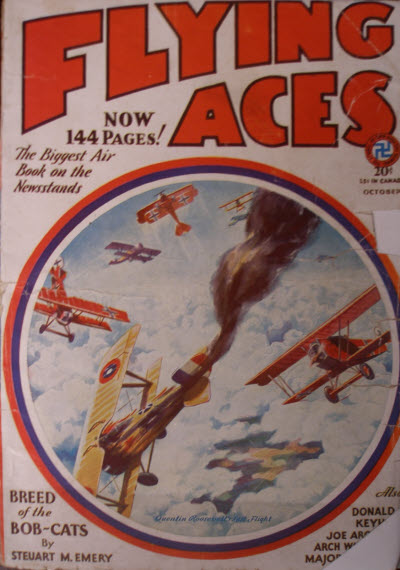 That sound can only mean one thing—that Bachelor of Artifice, Knight of Calamity and an alumnus of Doctor Merlin’s Camelot College for Conjurors is back to vex not only the Germans, but the Americans—the Ninth Pursuit Squadron in particular—as well. Yes it’s the marvel from Boonetown, Iowa himself—Lieutenant Phineas Pinkham!
That sound can only mean one thing—that Bachelor of Artifice, Knight of Calamity and an alumnus of Doctor Merlin’s Camelot College for Conjurors is back to vex not only the Germans, but the Americans—the Ninth Pursuit Squadron in particular—as well. Yes it’s the marvel from Boonetown, Iowa himself—Lieutenant Phineas Pinkham! 




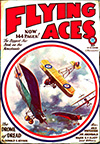
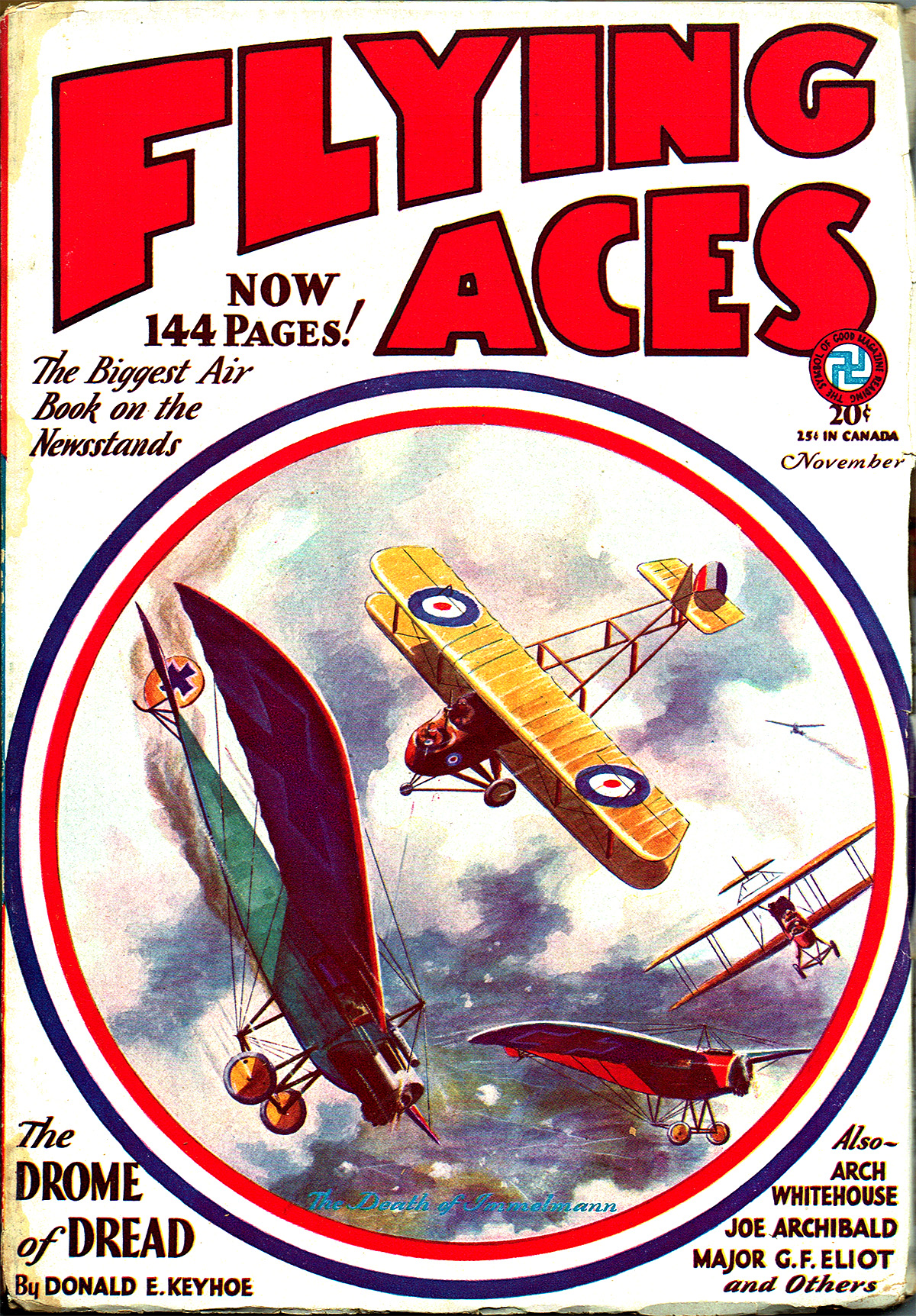
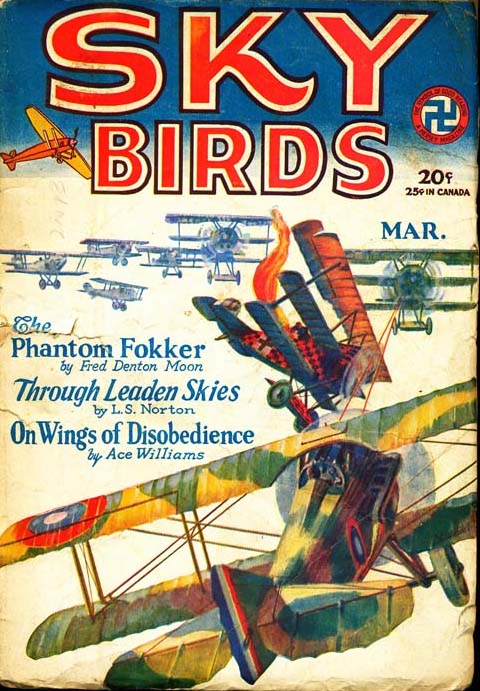 another one of the few stories from Fred Denton Moon. Moon was born in Athens, Georgia in 1905 and was a freelance writer. A former staff member of The Atlanta Journal Sunday Magazinesince 1930, he was the first editor of the Journal’s wire photo service as well as former city editor of the Journal. He was member of the Society of Professional Journalists/Sigma Delta Chi and retired from the Georgia Department of Labor in 1971. Moon died in 1982 at the age of 76.
another one of the few stories from Fred Denton Moon. Moon was born in Athens, Georgia in 1905 and was a freelance writer. A former staff member of The Atlanta Journal Sunday Magazinesince 1930, he was the first editor of the Journal’s wire photo service as well as former city editor of the Journal. He was member of the Society of Professional Journalists/Sigma Delta Chi and retired from the Georgia Department of Labor in 1971. Moon died in 1982 at the age of 76.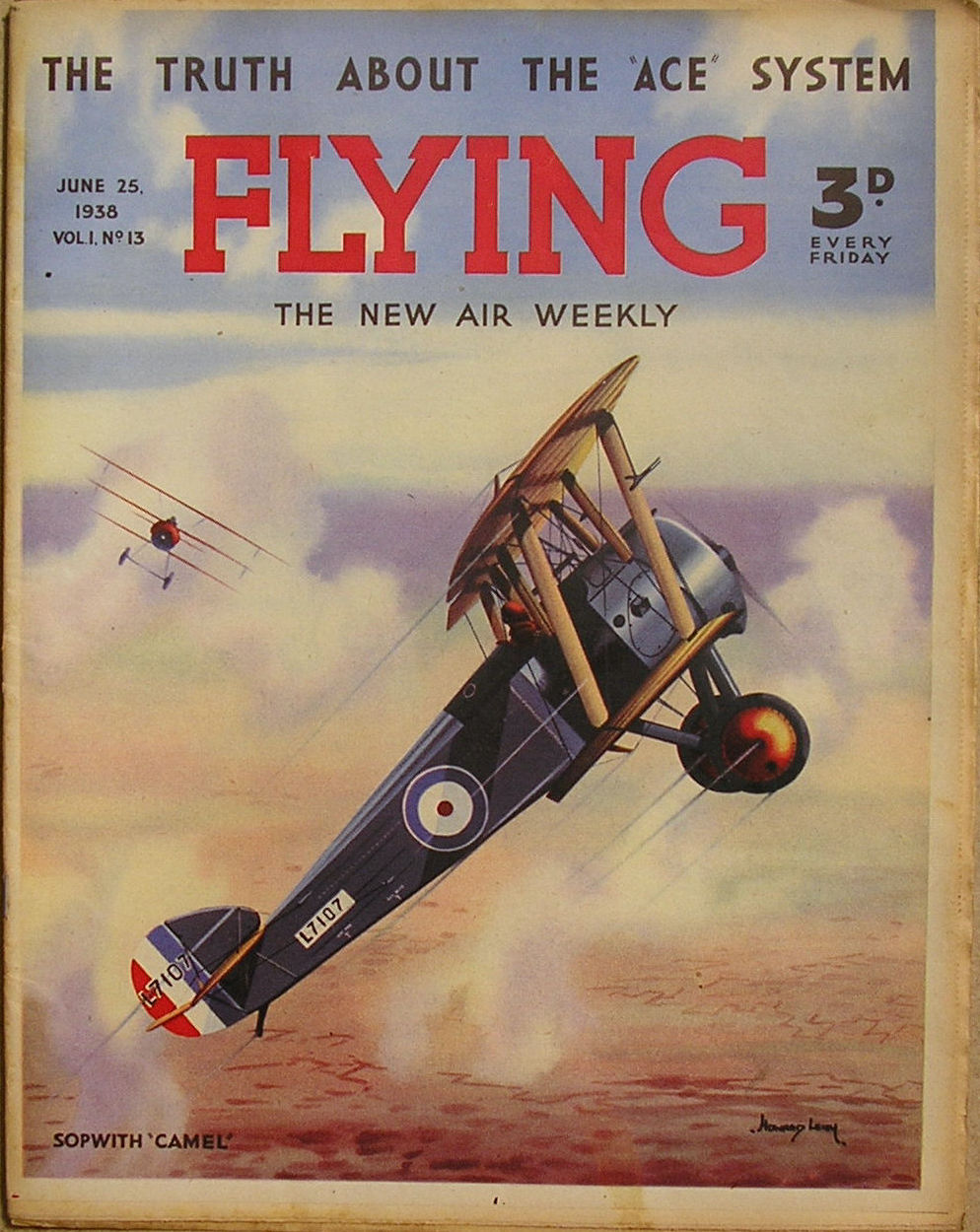 weekly paper of all things aviation, started up in England in 1938, amongst the articles and stories and photo features was an illustrative feature called “Heroes of the Air.” It was a full page illustration by S. Drigin of the events surrounding how the pictured Ace got their Victoria Cross along with a brief explanatory note.
weekly paper of all things aviation, started up in England in 1938, amongst the articles and stories and photo features was an illustrative feature called “Heroes of the Air.” It was a full page illustration by S. Drigin of the events surrounding how the pictured Ace got their Victoria Cross along with a brief explanatory note. 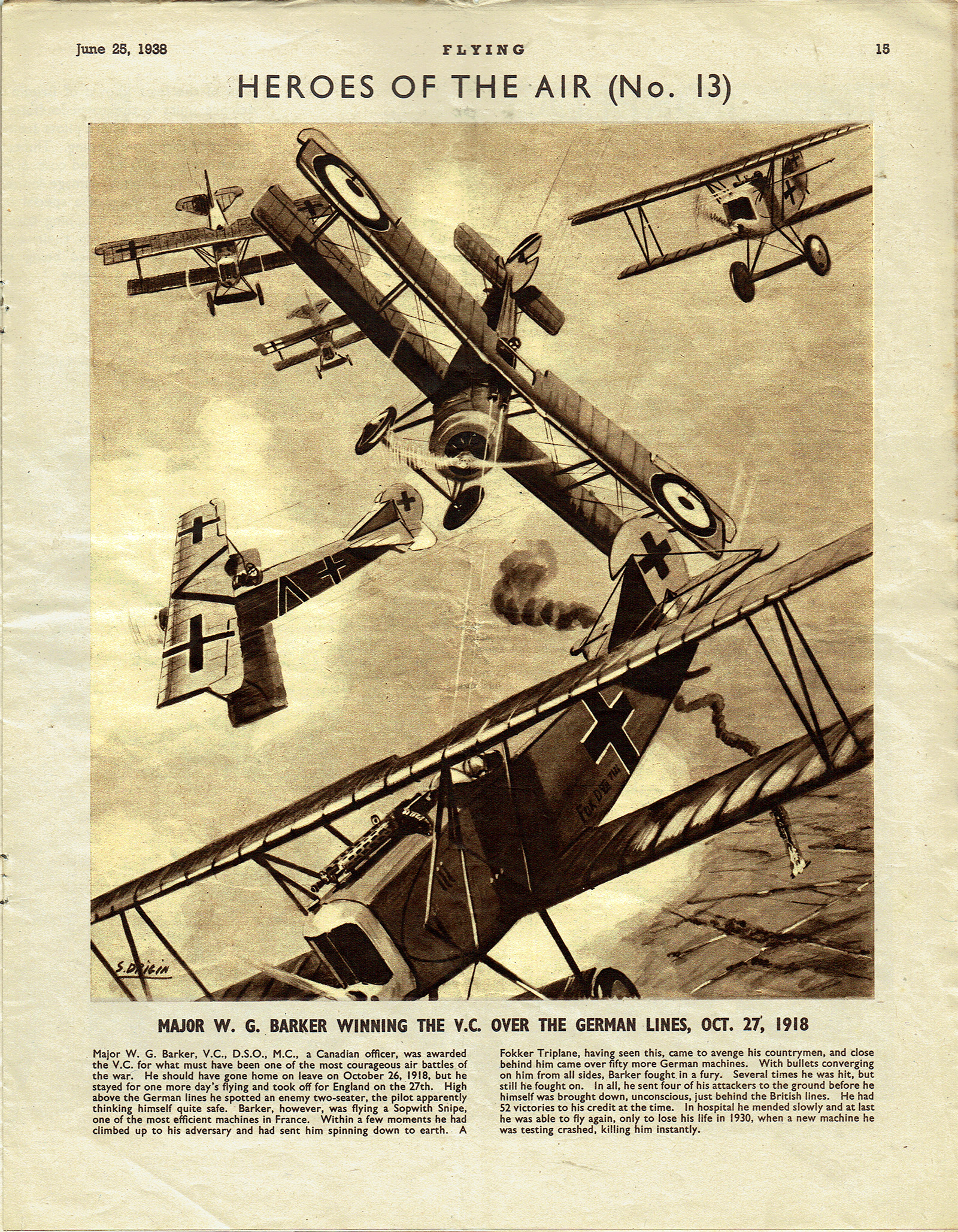
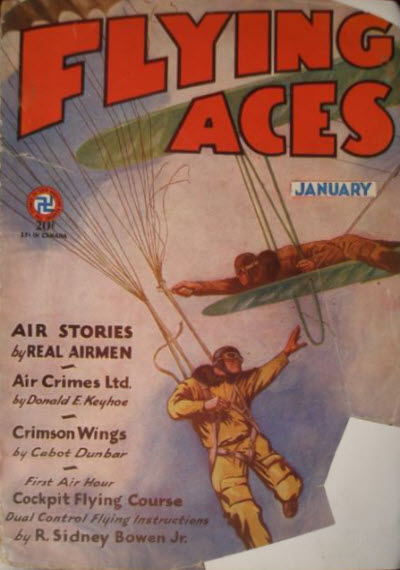 a story from the pen of Donald E. Keyhoe—his first in the pages of Flying Aces magazine, which ran a story by Keyhoe in most of their issue from January 1930 through September 1942, featuring characters like Richard Knight, Eric Trent or Captain Philip Strange! Before Keyhoe started up the series characters, he wrote other stories of then present day aviation situations. “Air Crimes, Limited” outlines how a massive criminal ring is using airplanes on a big scale for various crooked schemes. Captain Jack Collins of the Air Corp is tasked with infiltrating this organization and getting information that can be used to bring the organization down.
a story from the pen of Donald E. Keyhoe—his first in the pages of Flying Aces magazine, which ran a story by Keyhoe in most of their issue from January 1930 through September 1942, featuring characters like Richard Knight, Eric Trent or Captain Philip Strange! Before Keyhoe started up the series characters, he wrote other stories of then present day aviation situations. “Air Crimes, Limited” outlines how a massive criminal ring is using airplanes on a big scale for various crooked schemes. Captain Jack Collins of the Air Corp is tasked with infiltrating this organization and getting information that can be used to bring the organization down.  magazine has been exceedingly fortunate in securing Lt. Edward McCrae to conduct a technical department each month. It is Lt. Mcrae’s idea to tell us the underlying principles and facts concerning expressions and ideas of air-war terminology. Each month he will enlarge upon some particular statement in the stories of this magazine. Lt. MaCrae is qualified for this work, not only because he was a war pilot, but also because he is the editor of this fine magazine.
magazine has been exceedingly fortunate in securing Lt. Edward McCrae to conduct a technical department each month. It is Lt. Mcrae’s idea to tell us the underlying principles and facts concerning expressions and ideas of air-war terminology. Each month he will enlarge upon some particular statement in the stories of this magazine. Lt. MaCrae is qualified for this work, not only because he was a war pilot, but also because he is the editor of this fine magazine.


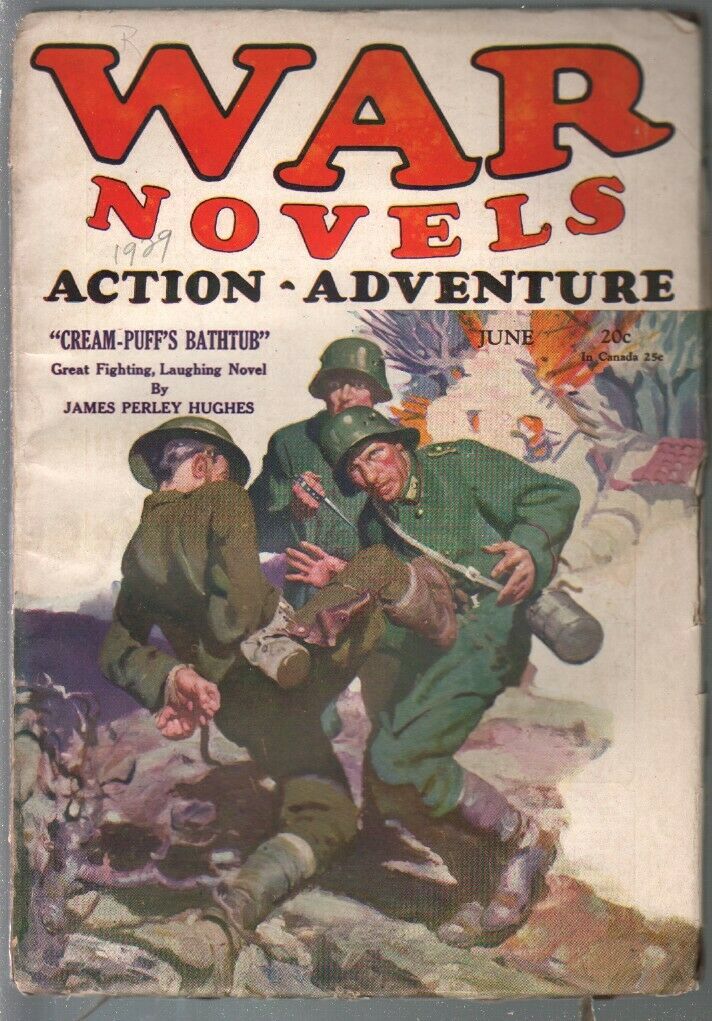 a story from the pen of a prolific pulp author O.B. Myers! Myers was a pilot himself, flying with the 147th Aero Squadron and carrying two credited victories and awarded the
a story from the pen of a prolific pulp author O.B. Myers! Myers was a pilot himself, flying with the 147th Aero Squadron and carrying two credited victories and awarded the